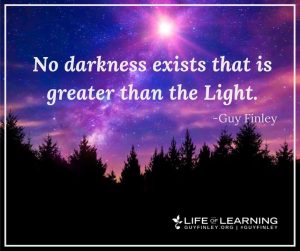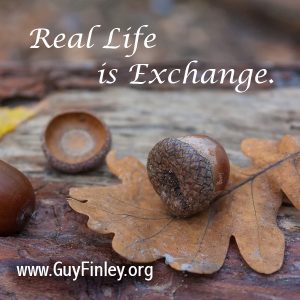As we’re reminded in Ecclesiastes, “To everything there is a season.” As each creation outlives its usefulness in one area of life, so does its purpose for being in existence change. For example, let’s look at the life of a simple leaf. As it’s born and slowly unfolds, it captures the soft light of spring and transfers this energy to the tree. Throughout the spring and summer, it serves this purpose. But come the fall, its service changes.
In its first birth, the leaf acts as an agent of conversion; it collects sunlight that, in turn, feeds the tree. But as the earth turns and fall moves into winter, the life of the leaf fades, dies, and drops to the earth. Its body is then slowly converted, becoming food for the same tree that it once helped to feed. And so the cycle of birth, death, and rebirth completes itself.
It’s quite clear: no natural creature can escape the laws that necessitate its form and function being exchanged. And further, within this complex matrix of constant exchange is the total interdependence of all that play their part within it. Science confirms this fact: from massive suns to tiny mustard seeds, each and all, in the scale of their being, run through this cycle of life and death. In the end, the tree is as choiceless about its fate as are the leaves born from its branches. Our identification with the coming and going of all these individual forms keeps us from seeing the undying nature that hides behind them.
It should also be clear that less evolved creatures such as leaves, trees, and myriad beasts sheltering in their shade have no awareness of how their forms—after fulfilling one purpose in life—are obliged to transition from one order of being into yet another. They travel in and out of their various forms oblivious to the greater consciousness that they represent and are obligated to serve.
Yet, hidden somewhere in the complex matrix of our essence lies harbored a higher order of consciousness—a celestial level of being far greater than any temporary form it will ever assume. This transcendent self-awareness remains changeless, true, and unflagging throughout time. It never falters, even as it watches the temporary form it occupies “die”—pass on—so that this body can fulfill its next role in nature’s designated plan. The awareness of this passage, which we alone are empowered to witness, has a name: it is called the dark night of the soul.
For those who aspire to know the immortal Self, the dark night of the soul is a required time of “unknowing.” It marks a period of transition, a rite of passage that necessarily repeats itself each time we reach the end of an existing set of possibilities. During these tribulations there is no consoling ourselves—former pride and passion are seen as stumbling blocks, as pointless as they are powerless to rescue us from the self we now see they conspired to create in us. We are literally in-between worlds, suspended there by a supernal light showing us who and what we can no longer be, and yet not revealing what lies ahead should we surrender ourselves to its revelation. Here we enter into the proverbial valley of the shadow of death.
Yet, notwithstanding the fear of having reached the end of oneself, something abides with us in the midst of this spiritual darkness. It speaks to us personally through what it reveals to us about our present nature, which is why the longer we’re willing to stand in the darkness of these light-induced revelations, the more surely do our eyes begin to see a secret inscription written there upon the heart. Part invocation and part invitation, its message is clear for all who have dared make it that far:
In times of great upheaval, if you will only agree to let go and die to yourself, it won’t be you who passes. So that not only will you bear witness to the sacrifice of yourself, but you will also see your own rebirth.

